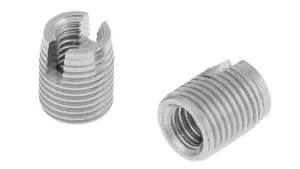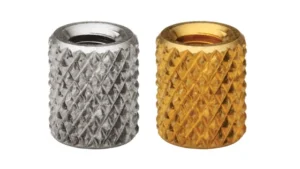Our Manufacturing Process
- Injection Molding
- Overmolding & Insert Molding
- Compression Molding
- Urethane Cast Molding

Insert Molding
Insert molding is an efficient manufacturing process that combines metal and plastic into a single molded part. This method is used to create durable bonded products. With applications spanning industries like automotive, electronics, and medical devices, insert molding offers an innovative solution for creating strong, lightweight components.
In this guide, we’ll explore the process, benefits, materials, and common applications of insert molding. You can continue reading or click and jump to the section you interested in.
Insert Molding Working Process
The insert molding process is a specialized type of injection molding that incorporates pre-formed components, or inserts, into plastic parts. This technique is commonly used to enhance the strength and functionality of molded products by embedding materials such as metals or ceramics within plastic. The steps of the insert molding process are as follows.
Loading Inserts into the Mold
The first step involves placing the selected inserts into the mold cavity. This can be done manually or through automated systems. Each method has its own advantages and considerations, depending on production requirements and operational efficiency.
Manual Loading
Manual loading involves an operator physically placing the inserts into the mold before the injection of molten plastic.
This method is often used in low to medium production volumes, offering flexibility in insert types and designs, and making it cost-effective for smaller batches. Additionally, operators can perform immediate quality checks, ensuring correct insert placement and preventing defects. However, manual loading can be labor-intensive, increasing costs for larger runs, and carries a higher risk of human error.
Automated Loading
Automated loading employs robotic systems to place inserts into the mold, enhancing efficiency and precision.
It is especially beneficial for high-volume production as robots work faster than humans, reducing cycle times and boosting productivity. This method also ensures consistent, accurate insert placement, minimizing errors and defects. Additionally, it lowers labor costs by reducing manual involvement. However, automated loading comes with a higher initial investment in equipment and requires a complex setup.
Injecting Molten Plastic
Once the inserts are securely in place, molten plastic is injected into the mold under high pressure. The pressure helps to fill the mold evenly and ensures that the molten plastic encapsulates the inserts completely, pushing out any trapped air.
Cooling and Solidification
After injection, the molten plastic is allowed to cool and solidify. During this phase, a holding pressure may be maintained to counteract any shrinkage as the plastic hardens.
Opening the Mold and Ejecting the Part
Once cooled, the mold opens, and the finished part, now integrated with the insert, is ejected. This part is ready for use or may undergo secondary operations if needed
Post-Process
After the initial molding process, the molded parts require further additional steps to enhance
Additional steps should be taken after the initial molding process to enhance the appearance, functionality, and performance of the molded parts. The post-process of Zhongren includes the following.
- Trimming and Deflashing: Remove excess material (flash) from the molded parts to achieve precise dimensions and improve aesthetics.
- Surface Finishing: Apply polishing, texturing, or coatings to enhance the visual appeal and tactile quality of the parts.
- Painting and Coating: Add color and protective layers using methods like spray painting or powder coating to improve appearance and durability.
- Laser Marking and Pad Printing: Add part numbers, logos, or other markings for identification and branding purposes.
- Heat Staking and Ultrasonic Welding: Secure inserts or additional components into the molded parts using heat or ultrasonic energy for a strong bond.
- Assembly: Integrate multiple components into a final product, if necessary, to complete the assembly process.
Common Materials for Insert Molding
In insert molding, both the plastic material and the insert must be carefully chosen to ensure proper bonding and functionality. It’s crucial to consult material experts when selecting materials for insert molding to optimize the performance of the final product.
Common Plastic Material
- Thermoplastics: Polypropylene (PP), Nylons (Polyamides/PA), polycarbonate (PC), ABS, Polyethylene (PE) and Acetal(POM);
- Thermoset: Epoxy resins, Phenolic resins, Polyester resins;
- Elastomers: Polyurethane, NR
Common Insert Materials
- Metal inserts
- Plastic inserts
- Ceramic inserts
- Glass fiber
- Magnets
Design Consideration of Insert Molding
Inserts Feature Consideration
The insert is the first factor to consider before insert molding. Whatever you decide to use it should be able to withstand the extreme temperature and pressure during the insert molding process.
Inserts should generally be small relative to the overall size of the molded part. A recommended guideline is that inserts should extend at least 0.016 inches (0.4 mm) into the cavity to prevent sink marks in the surrounding plastic. Additionally, the thickness of plastic beneath an insert should be at least one-sixth of its diameter to ensure structural integrity.
Consider using a round or axially symmetrical shape of the insert to promote uniform shrinkage and reduce stress concentrations. Shape edges should be avoided to minimize potential failure points. Incorporating knurling or grooves can enhance friction, helping secure the insert within the plastic during molding.
Knurling and groove inserts reference.



Proper Insert Location
The positioning of inserts within the mold is critical. Proper placement ensures that the inserts maintain their orientation and position throughout the injection process.
The design should also consider how much plastic will surround the insert to maintain its stability during injection, normally the inserts should be positioned in raised areas or bosses. The depth of the insert should exceed its height to provide sufficient mechanical strength and stability.
Material Selection and Compatibility
When selecting materials for insert molding, it is essential to ensure compatibility and performance between the insert and the surrounding plastic.
The insert material and the plastic must have similar thermal expansion rates to prevent stress and cracking during cooling. Mismatched expansion can lead to defects in the final product. The plastic resin should be chosen to ensure a strong bond, inserts made from metals like brass or stainless steel typically require plastics that can adhere well, such as Nylon or ABS。
Minimize the Gap Between Metal Inserts
A narrower gap between the metal insert and the molten plastic is crucial for enhancing the bond strength. This design choice allows for better encapsulation of the insert, leading to a more reliable composite product. A tight fit reduces the risk of air entrapment, which can compromise the integrity of the bond during cooling.
Mold Design Consideration
The mold must accommodate both the insert and the injected plastic material effectively. Key aspects include:
Cavity Pressure: This must be controlled to ensure a consistent bond between the insert and plastic.
Flow Paths: Designing efficient flow paths is essential to avoid voids or air pockets in the final part.
Gate Location: Proper placement of gates influences how well the molten plastic fills the mold and interacts with the inserts
Benefits of Insert Molding
This technique offers numerous advantages across various industries. Here are some key benefits:
Reduced Assembly Time and Costs
Insert molding eliminates the need for separate assembly steps, allowing multiple components to be combined into a single part in one operation. This significantly reduces labor costs and production time, streamlining the manufacturing process and minimizing the risk of assembly errors.
Enhanced Strength and Durability
The integration of metal or other strong inserts enhances the mechanical properties of plastic parts, providing increased strength and durability. This reinforcement helps parts withstand stress and impact better than standard plastic components, making them ideal for demanding applications.
Fewer Defects and Improved Product Quality
The process results in fewer defects due to the elimination of secondary assembly operations. The strong bond formed between the insert and plastic part reduces the likelihood of loosening or detachment during use, leading to higher reliability and customer satisfaction
Downside of Insert Molding
Insert molding also comes with several challenges and drawbacks, here are some key disadvantages of insert molding:
Complex Mold Design Requirements
The design of molds for insert molding is often more complex than traditional injection molding. Factors such as the insertion angle, perpendicularity, and precise placement of inserts increase the complexity of mold design and manufacturing processes. This complexity can lead to higher initial costs and longer lead times for mold production
Increased Cycle Times
The requirement for accurate placement of inserts can extend the overall cycle time of the injection molding process. Manual insertion methods, in particular, can be time-consuming, leading to reduced efficiency compared to fully automated processes.
Potential for Delayed Cracking
Insert molded parts may experience delayed cracking around the metal inserts due to stress from thermal expansion differences during cooling. This issue may not become apparent until some time after production, complicating quality control efforts
Common Application Examples of Insert Molding
Insert molding can create strong, durable components by encapsulating pre-formed inserts within plastic parts. The following are some common applications and examples of insert molding products.
Automotive Industry
- Sensor housing
- Connectors and switches
- Door handles
Aerospace Industry
- User interface switches
- Lightweight housing for radios
Consumer Electronics
- Integrating button
- Smartphones and laptops
- Knobs and controls
Insert Molding vs Overmolding
Insert molding is ideal for applications requiring strong mechanical integration of metal inserts with plastics, enhancing structural integrity and performance under stress. In contrast, overmolding excels in improving ergonomics and aesthetics by layering softer materials over harder substrates, making it suitable for consumer products that prioritize comfort and user experience. Following is a brief chart comparing the differences between insert molding and overmolding.
| Feature | Insert Molding | Overmolding |
|---|---|---|
| Process Type | Single-step process where pre-formed inserts are placed in the mold and plastic is injected around them. | Two-step process where a base part is molded first, followed by molding a second material over it. |
| Material Integration | Primarily integrates metal or other inserts into plastic parts. | Combines two or more materials, often using softer plastics over harder substrates. |
| Cycle Time | Generally longer due to the need for precise insert placement. | Typically shorter since it involves molding similar materials in succession. |
| Cost | More cost-effective for lower production volumes; simpler mold design. | Higher initial costs due to complex tooling and multiple steps; more economical for high volumes. |
| Production Volume Suitability | Best for lower production volumes where insert integration is beneficial. | More suitable for high production volumes due to shorter cycle times and efficiency gains. |
